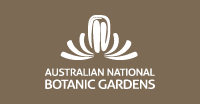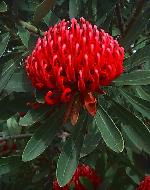Telopea 'Braidwood Brilliant'
by Iain Dawson
Recent interest in species suitable for cooler climates, especially he cut flower industry in New South Wales (NSW) and Victoria, has led to a resurgence of interest in the long established cultivar Telopea "Braidwood Brilliant". This hardy waratah was the result of a deliberate attempt to hybridise Telopea speciosissima and Telopea mongaensisin 1962. The breeding work was done at the Australian National Botanic Gardens (ANBG) but the name was not registered by the Australian Cultivar Registration Authority (ACRA) until 1974.
The pollen parent was T. speciosissima. The parent plant was carefully selected, by Rev. Colin Burgess, who collected pollen from individuals growing near Wentworth Falls high up in the Blue Mountains. It was hoped that these individuals, growing at 790 metres would have the best cold tolerance available in this species, which is usually considered to be rather frost sensitive. The pollen was used to fertilise the flowers of several T. mongaensis plants growing in Canberra in pots. Telopea mongaensis is a Southern Tablelands plants from near the old gold mining town of Braidwood, NSW. Whilst it is an attractive, growing to around 4 metres, the inflorescences are rather small and sparse in character. Its attraction for this breeding program was its frost hardiness as it grows satisfactorily in the Australian Capital Territory.
Twenty nine fertile seeds were produced and these were grown to maturity over the next few years. After further evaluation and selection "Braidwood Brilliant" was described and submitted to ACRA. It is "an upright and compact glabrous shrub" with an inflorescence that "is slightly less conical and less dense than T. speciosissima but vastly superior to T. mongaensis in this regard with a flower diameter of 6-8 cm". The flowers are cherry red (RHS (1966) Red 53B/C). It will grow to 2-3 metres tall and spread to about 4 metres.
It has several features that make it very suitable as a cut flower crop. Firstly it is frost tolerant, and will certainly grow beyond the range of T. speciosissima. Canberra has more than sixty frosts every year, with an average absolute minimum of -6 deg C. Despite this "Braidwood Brilliant" has been growing in ANBG for thirty years and appears not to have suffered any significant frost damage. Admittedly the location of ANBG is not the most extreme climate in the region, being on a north-east facing slope gives an early position and some cold air drainage, and there is also some protection from surrounding trees. However it indicates climatic suitability for most sites that are likely to be used for flower farms in cooler areas. Secondly it is very floriferous, with flowers open over a four week period in Spring (usually late October to early November here in Canberra). It also has a tendency to abort its bracts, which is a neat way of avoiding bract burn, one of the serious problems encountered by waratah growers!
Like all waratahs it prefers well drained sandy soils. However it will grow in raised beds (30 cm) over heavy soils. Care should be taken with phosphorous levels complete fertilisers should therefore be avoided unless they have been especially formulated for natives. In our experience it is less susceptible to fungal problems such as leaf spot and stem canker than T. speciosissima, but watch out for diaspidid scale, bud worm and fruit tree stem girdler. Parrots also find them very attractive.
For the record, the reverse cross (T. mongaensis as the pollen parent) gave the cultivar "Doug's Hybrid" now known as "Canberry Gem". This is hard to distinguish from "Braidwood Brilliant" and appears to have similar characteristics except it is not as frost hardy. A fine example can be seen at the front gates of ANBG.
Telopea "Braidwood Brilliant" is being released by Proteaflora (Monbulk, Victoria) this Spring. More information on the cultivation of waratahs is available in "The Waratah" by Paul Nixon (Kangaroo Press) and "Australian Plants" (Society for Growing Australian Plants, June 1996).
Images of Telopea 'Braidwood Brilliant'
Click on a small image to retrieve a larger image.
![]() A close-up of a Telopea "Braidwood Brilliant" inflorescence.
A close-up of a Telopea "Braidwood Brilliant" inflorescence.
![]() A close-up of a Telopea "Braidwood Brilliant" inflorescence.
A close-up of a Telopea "Braidwood Brilliant" inflorescence.
![]() A view of a number of Telopea "Braidwood Brilliant" inflorescences.
A view of a number of Telopea "Braidwood Brilliant" inflorescences.
![]() A view of the whole plant of Telopea "Braidwood Brilliant".
A view of the whole plant of Telopea "Braidwood Brilliant".
Iain Dawson was in charge of Horticultural Research at the Australian National Botanic Gardens in Canberra and also Registrar of the Australian Cultivar Registration Authority. He retired in 2003.
Acknowledgements: Many people were involved in the creation of this cultivar, including Dr Robert Boden, Rev. Colin Burgess, Mr Rudolph Willing and Mr R.H. Powell and the staff of ANBG. The author also acknowledges the work of Mr Tony Harris, who documented the story of "Braidwood Brilliant" in an unpublished student assignment in 1986 and the ACRA for the cultivar description.
Further information and images of Telopea can be found here.
![An Australian Government Initiative [logo]](/images/austgovt_brown_90px.gif)








